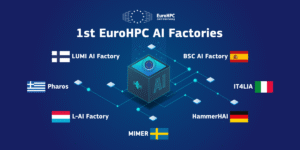European AI Push: strategy, momentum, and the road ahead
Europe’s AI story has shifted from cautious regulation to active, strategic acceleration. For years the continent positioned itself as the moral counterweight to Silicon Valley — stressing privacy, safety, and human-centric values — often at the cost of speed and scale. That is changing. In 2024–2025 Europe moved beyond principles-only debates and began stacking laws, funding programmes, infrastructure projects and industrial partnerships to build domestic capability in AI research, chips, cloud and data — while still trying to preserve core European values. This article unpacks the layers of the “European AI push”: what’s new, what’s working, the limits, and what to watch next. digital-strategy.ec.europa.eu+2digital-strategy.ec.europa.eu+2
1. From regulation to strategic industrial policy
The European Union’s landmark AI Act — the first comprehensive AI regulation of its kind — set the tone: strict, risk-based rules that aim to protect citizens while creating legal certainty for businesses. The Act seeks to ban highest-risk uses (for example certain untargeted social scoring) and impose robust obligations on high-risk systems and general-purpose models. Those rules put Europe at the head of global governance debates, but they also forced policymakers to accept that regulation alone won’t deliver competitiveness. To remain influential, Europe needs both safeguards and scale. digital-strategy.ec.europa.eu
That realization birthed a complementary push: pro-growth, industrial policy focused on supply chains, sovereign data infrastructure, compute and talent. Programmes such as the Digital Europe Programme and targeted calls like GenAI4EU funnel public funding into generative AI adoption, model development and public sector pilots — signalling that Europe intends to be a producer, not just a regulator, of AI. digital-strategy.ec.europa.eu+1
2. Money talks: funding and the new investment landscape
Public funding is converging with private capital to catalyse scale-ups. The EU and member states have layered multiple instruments — grants through Horizon Europe, procurement and investments via Digital Europe, and sector-specific funds such as the Chips Act — to support R&D, industrial deployment and market adoption.
At the same time, European startups are attracting massive private rounds. A recent high-profile deal illustrated this new dynamic: Mistral AI, a French model builder, secured a blockbuster funding round in 2025 with significant investment from ASML — a deal that both validates Europe’s home-grown talent and ties AI ambitions to the semiconductor industry. This blend of public funding and strategic private partnerships is precisely what policymakers had in mind when they argued for an “industrial” approach to AI competitiveness. Reuters+1
3. Chips, cloud and data: the three infrastructure pillars
AI at scale needs three infrastructure pillars: advanced semiconductors, trustworthy cloud and rich, accessible datasets — and Europe has specific programmes for each.
Semiconductors: the Chips Act
The EU Chips Act provides major subsidies, incentives and a strategic framework to double Europe’s share of global chip production and strengthen domestic capabilities for advanced packaging and fabrication. The goal: reduce dependence on overseas suppliers and ensure that European AI systems have resilient access to the compute they need. This is a long-term play — semiconductor capacity takes years to build — but it’s essential to any credible sovereignty strategy for AI. CSIS+1
Cloud & Data: GAIA-X and trusted ecosystems
GAIA-X, the European initiative to create federated, interoperable and “trust-labelled” cloud and data services, has evolved into a practical building block for data sovereignty. Through trust labels, technical standards and a federated governance model, GAIA-X aims to enable cross-border data sharing while complying with EU data protection law — a useful foundation for sector-specific data spaces (health, mobility, industry) that can feed European models and applications. Recent assemblies and roadmap publications show the initiative moving from concept to implementation. gaia-x.eu+1
Data availability: public sector as an accelerator
EU funding streams increasingly encourage public sector organisations to open useful, anonymised datasets and to pilot generative AI solutions in healthcare, agriculture and public administration. When combined with GAIA-X style governance, these datasets can help European researchers and startups train competitive models without violating privacy or regulatory constraints.
4. The foundation-model question: build, partner or regulate?
Foundational models (large pre-trained models that power downstream apps) are the strategic centrepiece of modern AI. Europe faces three options: build competing models domestically, create favourable conditions to host/modify global models locally, or push strict rules that slow adoption. Reality will be a hybrid.
European institutions are pushing for a middle path: encourage domestic capability (grants and public procurement for model development), set guardrails that ensure transparency and safety, and incentivise “trusted” versions of general-purpose models tailored for EU needs. The European Economic and Social Committee and other bodies have emphasised the need to foster generative AI while managing risks — a delicate balancing act. European Economic and Social Committee
Programs like GenAI4EU channel funding for generative AI research and deployment, signalling that Europe doesn’t want to cede the future of foundation models to external players. But building models at the scale of the biggest U.S. labs requires huge compute and data advantages — which is why the EU’s infrastructure push is tightly coupled with these model ambitions. digital-strategy.ec.europa.eu
5. National champions and cross-border ecosystems
Europe’s approach is neither fully centralised nor purely national. Member states have launched national AI strategies and investment packages — France’s “Make France an AI Powerhouse” and Germany’s KI-Strategie are prominent examples — while the EU coordinates cross-border funding and regulation. This dual-track approach has pros and cons.
Localised national programs let countries focus on strengths (e.g., France’s strong research clusters and startup funding, Germany’s industrial AI focus), but they risk fragmentation. EU-level instruments (funding calls, procurement, rules) try to knit these efforts into a single market for AI. The success of the European AI push depends on harmonising incentives so talent and capital can flow across borders rather than being siloed. businessfrance.fr+1
6. Use cases where Europe can lead — and already is
Europe has credible first-mover advantages in sectors where regulation, privacy and trust are differentiators:
-
Regulated industries (healthcare, finance, mobility): The strict privacy regime and high-quality public datasets make Europe a natural testbed for privacy-preserving AI (federated learning, differential privacy).
-
Industrial AI and manufacturing: Strong manufacturing bases (Germany, Netherlands) and initiatives linking AI to Industry 4.0 create fertile ground for industrial digital twins and predictive maintenance.
-
Green and energy transition AI: Europe can use AI to optimise grids, reduce emissions and manage renewables integration — areas with high social value and funding priority.
-
Public sector & governance tools: With its emphasis on trustworthy AI, Europe can lead in transparent AI deployments for public services, providing blueprints other regions may copy.
These vertical strengths are precisely where the EU’s regulatory approach can be an asset rather than a liability — by enabling adoption among risk-averse institutions that prioritise safety and compliance.
7. Risks and structural challenges
Europe’s plan is bold but faces meaningful obstacles:
-
Scale & compute gap: Building foundation models and training large networks requires immense GPU/accelerator farms. Despite Chips Act funding, Europe currently lags major cloud and compute providers in absolute capacity.
-
Talent competition: Top AI researchers and engineers continue to gravitate to U.S. and Chinese tech hubs offering higher salaries, research budgets, and data access. National and EU-level talent programmes help, but competition is fierce.
-
Fragmentation risk: Differing national priorities, procurement rules and procurement budgets can fragment demand and slow the creation of continental-scale champions.
-
Speed vs. safety trade-offs: Rigorous safety rules can slow time-to-market. The challenge is designing processes that protect citizens without making compliant products uncompetitive.
-
Dependence on non-European cloud & hardware vendors: Many European projects still rely on U.S. or Asian cloud providers and accelerators, creating geopolitical constraints.
Addressing these requires continued coordination between EU institutions, member-states, private sector and academia — and realistic expectations about timelines.
8. Private sector momentum and strategic partnerships
Europe’s private sector is stepping up. The Mistral–ASML investment is a signal event: a European model builder attracting strategic capital from a European semiconductor giant. Such partnerships matter because they link AI model expertise to the upstream hardware and industrial customers necessary for real-world deployments. Beyond headline deals, an ecosystem of startups, scale-ups and specialized research labs is maturing across Paris, Berlin, Amsterdam and other hubs. Reuters
At the same time, multinational cloud providers and chipmakers are increasingly partnering with European players on localisation, secure cloud offerings and co-investments — a pragmatic recognition that Europe is a priority market with a strong regulatory identity.
9. What success looks like by 2030
If the European AI push succeeds, by 2030 we would likely see:
-
A handful of scalable European model providers and many specialised domain models (health, industry, law) trained on EU datasets.
-
Robust, interoperable GAIA-X-style data spaces across sectors powering trustworthy AI services.
-
Substantially increased domestic chip packaging and assembly capacity, with stronger ties between hardware and AI software ecosystems.
-
Mature public procurement mechanisms that accelerate trustworthy AI adoption in government services and healthcare.
-
A regulatory ecosystem (AI Act plus clarifying guidelines) that supports innovation while maintaining high protections.
These outcomes depend on preserving the balance: strong safety guardrails, targeted public investment, active talent policies and cross-border coordination.
10. Policy recommendations — how to keep momentum without losing values
To turn ambition into durable capability, policymakers should pursue a pragmatic mix of measures:
-
Invest in distributed compute & shared facilities. Create EU-backed compute hubs accessible to academia and startups on competitive terms to close the compute gap quickly.
-
Scale public procurement as a market-shaper. Use procurement to fund pilot deployments of trustworthy AI, lowering adoption risk for SMEs.
-
Focus on specialised models & domain leadership. Prioritise sectors where European regulation and public data confer advantages (healthcare, energy, transport).
-
Attract and retain talent. Scholarships, visa facilitation for researchers, and attractive research funding are critical to counter brain drain.
-
Incentivise industry–hardware linkages. Encourage partnerships between AI firms and semiconductor manufacturers so compute supply and model demand develop in concert.
-
Operationalise GAIA-X with measurable milestones. Move from trust frameworks to tangible data spaces that reduce friction for cross-border R&D and model training.
11. Conclusion — pragmatic ambition
Europe’s AI push is now a two-track strategy: rigorous governance and aggressive industrial policy. It’s an attempt to prove that principled AI can scale without being outcompeted. The outcome will hinge on how well the EU and member states translate rules and funding into real infrastructure, compute, and market demand — and on whether private capital and industrial champions respond by building at scale within Europe.
The recent public–private momentum (from GenAI funding calls to headline investment rounds) shows Europe is serious. But the clock is ticking: AI is a global race defined by compute, data and talent. Europe’s distinct advantage — trust, regulatory credibility and sectoral depth — can become a global competitive edge if matched by focused investment, pragmatic partnerships and rapid implementation. The next five years will tell whether Europe turns its regulatory leadership into technological leadership — or remains the world’s conscience while others capture the lion’s share of AI’s commercial value. Reuters+4digital-strategy.ec.europa.eu+4digital-strategy.ec.europa.eu+4
For quick updates, follow our whatsapp channel –https://whatsapp.com/channel/0029VbAabEC11ulGy0ZwRi3j
https://bitsofall.com/new-ai-browsers-redefining-the-way-we-surf-the-web/
https://bitsofall.com/https-yourblog-com-alibaba-qwen3-next-llm-efficiency-frontier/
India’s Big Bet: Launching Incentives for Homegrown Foundational AI Models
MLOps and Automation: Driving the Future of AI and Machine Learning








